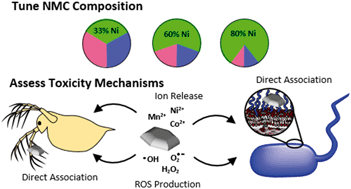当前位置:
X-MOL 学术
›
Environ. Sci.: Nano
›
论文详情
Our official English website, www.x-mol.net, welcomes your
feedback! (Note: you will need to create a separate account there.)
Nickel enrichment of next-generation NMC nanomaterials alters material stability, causing unexpected dissolution behavior and observed toxicity to S. oneidensis MR-1 and D. magna
Environmental Science: Nano ( IF 5.8 ) Pub Date : 2019/12/23 , DOI: 10.1039/c9en01074b Joseph T. Buchman 1, 2, 3, 4 , Evan A. Bennett 4, 5, 6, 7 , Chenyu Wang 1, 4, 8, 9 , Ali Abbaspour Tamijani 1, 4, 10, 11 , Joseph W. Bennett 1, 4, 10, 11 , Blake G. Hudson 1, 4, 10, 11 , Curtis M. Green 1, 4, 8, 9 , Peter L. Clement 1, 2, 3, 4 , Bo Zhi 1, 2, 3, 4 , Austin H. Henke 1, 4, 8, 9 , Elizabeth D. Laudadio 1, 4, 8, 9 , Sara E. Mason 1, 4, 10, 11 , Robert J. Hamers 1, 4, 8, 9 , Rebecca D. Klaper 4, 5, 6, 7 , Christy L. Haynes 1, 2, 3, 4
Environmental Science: Nano ( IF 5.8 ) Pub Date : 2019/12/23 , DOI: 10.1039/c9en01074b Joseph T. Buchman 1, 2, 3, 4 , Evan A. Bennett 4, 5, 6, 7 , Chenyu Wang 1, 4, 8, 9 , Ali Abbaspour Tamijani 1, 4, 10, 11 , Joseph W. Bennett 1, 4, 10, 11 , Blake G. Hudson 1, 4, 10, 11 , Curtis M. Green 1, 4, 8, 9 , Peter L. Clement 1, 2, 3, 4 , Bo Zhi 1, 2, 3, 4 , Austin H. Henke 1, 4, 8, 9 , Elizabeth D. Laudadio 1, 4, 8, 9 , Sara E. Mason 1, 4, 10, 11 , Robert J. Hamers 1, 4, 8, 9 , Rebecca D. Klaper 4, 5, 6, 7 , Christy L. Haynes 1, 2, 3, 4
Affiliation

|
Lithium intercalation compounds, such as the complex metal oxide, lithium nickel manganese cobalt oxide (LiNixMnyCo1−x−yO2, herein referred to as NMC), have demonstrated their utility as energy storage materials. In response to recent concerns about the global supply of cobalt, industrially synthesized NMCs are shifting toward using NMC compositions with enriched nickel content. However, nickel is one of the more toxic components of NMC materials, meriting investigation of the toxicity of these materials on environmentally relevant organisms. Herein, the toxicity of both nanoscale and microscale Ni-enriched NMCs to the bacterium, Shewanella oneidensis MR-1, and the zooplankton, Daphnia magna, was assessed. Unexpectedly, for the bacteria, all NMC materials exhibited similar toxicity when used at equal surface area-based doses, despite the different nickel content in each. Material dissolution to toxic species, namely nickel and cobalt ions, was therefore modelled using a combined density functional theory and thermodynamics approach, which showed an increase in material stability due to the Ni-enriched material containing nickel with an oxidation state >2. The increased stability of this material means that similar dissolution is expected between Ni-enriched NMC and equistoichiometric NMC, which is what was found in experiments. For S. oneidensis, the toxicity of the released ions recapitulated toxicity of NMC nanoparticles. For D. magna, nickel enrichment increased the observed toxicity of NMC, but this toxicity was not due to ion release. Association of the NMC was observed with both S. oneidensis and D. magna. This work demonstrates that for organisms where the major mode of toxicity is based on ion release, including more nickel in NMC does not impact toxicity due to increased particle stability; however, for organisms where the core composition dictates the toxicity, including more nickel in the redesign strategy may lead to greater toxicity due to nanoparticle-specific impacts on the organism.
中文翻译:

下一代NMC纳米材料的镍富集会改变材料的稳定性,导致意想不到的溶解行为并观察到对S.oneidensis MR-1和D.magna的毒性
锂插层化合物,例如复合金属氧化物,锂镍锰钴氧化物(LiNi x Mn y Co 1- x - y O 2,在本文中称为NMC),已证明其可用作储能材料。为了响应最近对钴的全球供应的担忧,工业合成的NMC正在转向使用具有丰富镍含量的NMC组合物。但是,镍是NMC材料中毒性更大的成分之一,值得对这些材料对环境相关生物的毒性进行研究。在此,纳米级和微米级富Ni的NMC对细菌希瓦氏菌(Shewanella oneidensis)的毒性评估了MR-1和浮游动物水蚤(Daphnia magna)。出乎意料的是,尽管每种细菌中的镍含量不同,但以相同的基于表面积的剂量使用时,对于细菌而言,所有NMC材料都表现出相似的毒性。因此,使用组合的密度泛函理论和热力学方法对材料溶解到有毒物质(即镍和钴离子)进行了建模,这表明由于含镍镍含量高的氧化态> 2的富镍材料,材料的稳定性有所提高。这种材料提高的稳定性意味着在富镍NMC和等化学计量NMC之间有望实现相似的溶解,这是在实验中发现的。对于沙门氏菌,释放的离子的毒性概括了NMC纳米颗粒的毒性。为了D. magna镍的富集增加了NMC的观察到的毒性,但这种毒性不是由于离子释放引起的。观察到NMC与S. oneidensis和D. magna都有关联。这项工作表明,对于主要的毒性模式是基于离子释放的生物,NMC中包含更多的镍不会由于颗粒稳定性的提高而影响毒性。但是,对于核心成分决定毒性的生物,由于纳米粒子对生物的特定影响,在重新设计策略中包括更多的镍可能导致更大的毒性。
更新日期:2020-02-20
中文翻译:

下一代NMC纳米材料的镍富集会改变材料的稳定性,导致意想不到的溶解行为并观察到对S.oneidensis MR-1和D.magna的毒性
锂插层化合物,例如复合金属氧化物,锂镍锰钴氧化物(LiNi x Mn y Co 1- x - y O 2,在本文中称为NMC),已证明其可用作储能材料。为了响应最近对钴的全球供应的担忧,工业合成的NMC正在转向使用具有丰富镍含量的NMC组合物。但是,镍是NMC材料中毒性更大的成分之一,值得对这些材料对环境相关生物的毒性进行研究。在此,纳米级和微米级富Ni的NMC对细菌希瓦氏菌(Shewanella oneidensis)的毒性评估了MR-1和浮游动物水蚤(Daphnia magna)。出乎意料的是,尽管每种细菌中的镍含量不同,但以相同的基于表面积的剂量使用时,对于细菌而言,所有NMC材料都表现出相似的毒性。因此,使用组合的密度泛函理论和热力学方法对材料溶解到有毒物质(即镍和钴离子)进行了建模,这表明由于含镍镍含量高的氧化态> 2的富镍材料,材料的稳定性有所提高。这种材料提高的稳定性意味着在富镍NMC和等化学计量NMC之间有望实现相似的溶解,这是在实验中发现的。对于沙门氏菌,释放的离子的毒性概括了NMC纳米颗粒的毒性。为了D. magna镍的富集增加了NMC的观察到的毒性,但这种毒性不是由于离子释放引起的。观察到NMC与S. oneidensis和D. magna都有关联。这项工作表明,对于主要的毒性模式是基于离子释放的生物,NMC中包含更多的镍不会由于颗粒稳定性的提高而影响毒性。但是,对于核心成分决定毒性的生物,由于纳米粒子对生物的特定影响,在重新设计策略中包括更多的镍可能导致更大的毒性。











































 京公网安备 11010802027423号
京公网安备 11010802027423号